Ahsan A. (ed.) Evaporation, Condensation and Heat transfer
Подождите немного. Документ загружается.

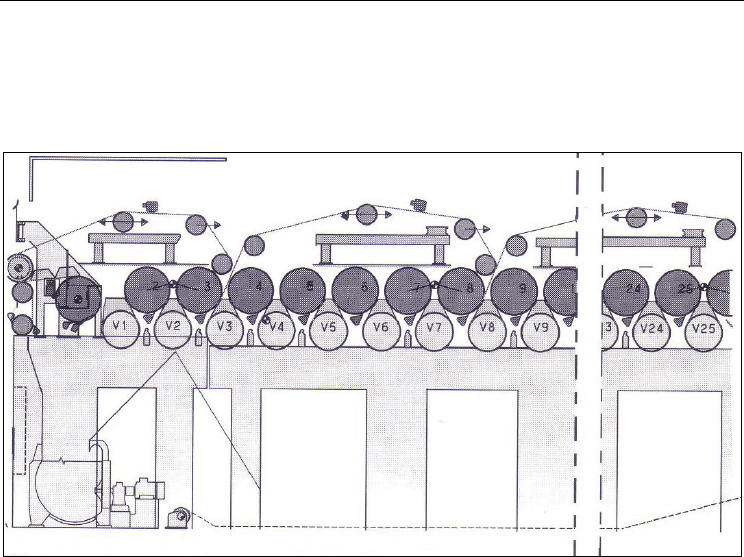
Fundamentals of Paper Drying – Theory and Application from Industrial Perspective
549
Runnability becomes an important issue with two-tier configuration with increased machine
speed due to web and edge breaks. To overcome this problem, single tier configuration was
introduced, although later part of the dryer section always has two-tier configuration.
Figures 4.2 and 4.3 show the ‘conventional’ double-felted two-tier and single-tier
configuration of multi-cylinder dryers respectively.
Fig. 4.3 Single dryer configuration
4.2 Drying cycle
The multi-cylinder drying process consists of repeated cycles in the direction of web travel.
Each cycle has different phases depending on the dryer configuration (Nissan and Hansen,
1960, 1961). Figure 4.4 shows the four phases of drying cycle for two-tier and double felted
configuration. Every phase has individual heat and mass transfer mechanism, a specific
evaporation rate and a web temperature
The four phases can be detailed as follows:
• The sheet is in contact with the outer surface of cylinder, while its other side is exposed
to air and evaporation is low in this phase.
• The sheet remains in contact with the cylinder surface and is covered on its outer
surface by the felt that applies pressure on the web. Heat transferred is increased but
mass transfer is limited because of the fabric covering the sheet surface. Sheet
temperature increase during this long phase and most of the heat transfer occurs.
• The fabric comes away from the sheet, which remains in contact with the cylinder.
Evaporation occurs from the newly exposed surface of the sheet not in contact with the
cylinder.
• The sheet is no longer in contact with the cylinder and is moving toward the next
cylinder. Evaporation occurs from both sides of the sheet, resulting in a decrease in
sheet temperature. It is during this phase that the evaporation rate is highest.
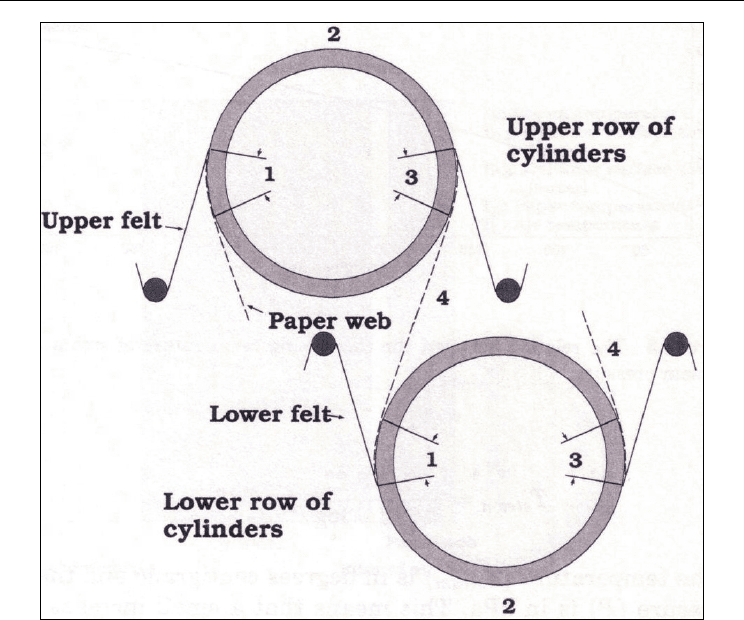
Evaporation, Condensation and Heat Transfer
550
Fig. 4.4 Four phases of drying with conventional double tier configuration.
5. Steam and condensate system
In modern paper machines there are several points in the steam and condensate system.
These include dryers, steam box, pocket ventilation equipment, roll handling, wire pit and
process water heating and machine room ventilation. In terms of paper drying, the main
steam and condensate consumption points are the dryer section and pocket ventilation as
heat energy required to dry paper are sourced from dryer cylinders and hot ventilation air.
The basic requirements and objectives of the steam and condensate system are to:
• allow maximum unrestricted drying of the paper with a gradual increase in cylinder
surface temperature from the wet end to the dry end;
• provide drying control for machine operator; remove air and non-condensibles;
• provide maximum condensate removal at all paper machine speeds;
• economic utilization of steam;
• provide uniform reel moisture and provision of sheet breaks differential and control.
Figure 5.1 shows the basic steam and condensate system of a commercial paper machine.
There are a number of variations in steam and condensate system depending upon the
machine design. In fact every paper machine has its own unique steam and condensate
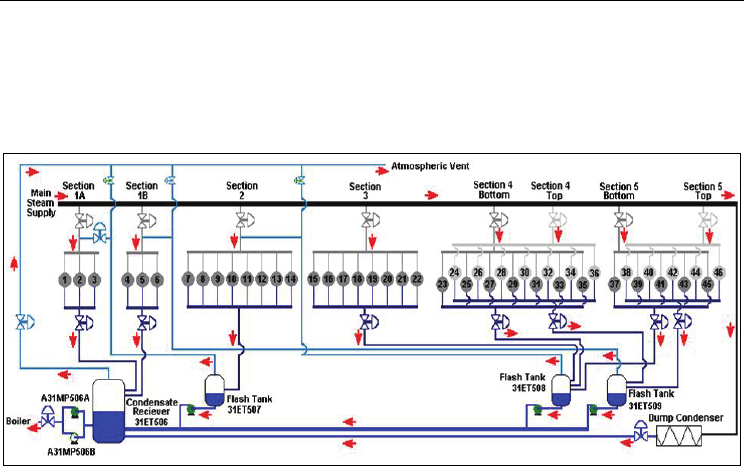
Fundamentals of Paper Drying – Theory and Application from Industrial Perspective
551
system. The design of steam and condensate system is influenced by available steam
pressure, machine speed, grammage or basis weight range, sheet dryness after the press
section and quality requirements of the finished products. The steam and condensate
systems for different paper grades are either cascade systems, thermo-compressor systems
or combinations of the two.
Fig. 5.1 Basic steam and condensate system of a commercial paper machine.
5.1 Condensate behaviour
In multicylinder paper drying system where steam is used as the source of heat energy, the
heat inside the cylinder is released by condensation of steam. The condensate inside the
cylinder needs to be evacuated for effective heat transfer from inside the dryer cylinder to
the dryer surface and subsequently to the paper. Steam is generally introduced into the
cylinder on the drive side of the paper machine, while condensate is evacuated from the
front side using either rotary or stationary siphons as shown in Figure 4.1 in Section 4.
As indicated earlier, condensate film that are present inside dryer cylinder play significant
role in overall heat transfer to the dryer surface. As the dryer begins to rotate and as speed
increases, the condensate will go through three stages, puddling, cascading and rimming as
shown in Figure 5.2. At
very low speed, condensate collects at the bottom of dryer as a
puddle, and only a thin film or no film at all on the shell wall. Under this condition, the
steam entering the dryer can easily condense directly on the wall of the dryer providing
excellent heat transfer. As speed increases, the condensate is carried up the cylinder wall
and forms a relatively thin uniform film. The velocity of the condensate film is lower than
that of the dryer shell and on-set of ‘rimming’ appear. This produces a slippage, which tends
to assist heat transfer. As the speed increases above 300 m/min, the slippage also decreases
and eventually complete rimming occurs. Complete rimming is desirable in terms of
uniform heat transfer.
To improve heat transfer for dryers operating at higher than the rimming speed, more than
300 m/min, turbulence of the condensate later is generated by installation of turbulator or
spoiler bars inside the dryer shell. Depending upon the diameter of the dryer, between 18 and
30 bars per dryer are used. Turbulence generated due to dryer bars is shown in Figure 5.3.
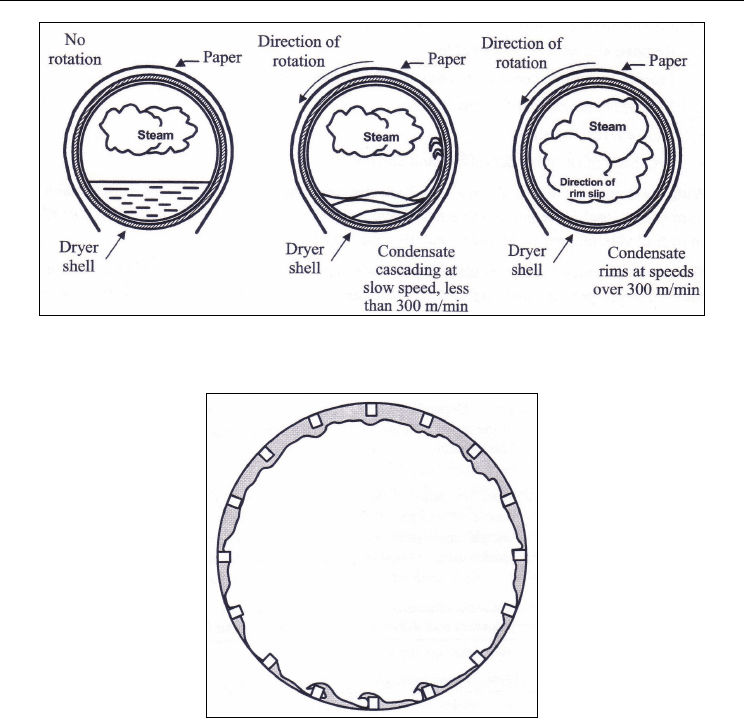
Evaporation, Condensation and Heat Transfer
552
Puddle or pond Cascading Rimming
Fig. 5.2 Different forms condensate behaviour inside dryer cylinder
Fig. 5.3 Turbulent action produced by dryer bars
5.2 Condensate evacuation and blow-through steam
Siphon and steam joint are the heart of condensate removal from the dryer shell. To obtain
the maximum heat from steam, ideally all the steam must be condensed. In practice, this
never happens inside the dryer shell. Depending upon the dryer speed a percentage of
steam of total steam entering the dryer shell is never condensed and leaves the dryer mixed
with condensate as two-phase flow and the uncondensed steam in the condensate is called
‘blow-through steam’. A differential pressure across the dryer or a group of dryer is
necessary to obtain continuous evacuation of condensate through a siphon which is located
inside the dryer shell.
The siphons could be of stationary or rotary type. The quantity of blow-through steam of the
total steam supplied to the dryer is about 10%-20% for stationary siphons and 25%-30% for
rotary siphons. Stationary siphons use the condensate kinetic energy in condensate removal.
For rotary siphons, the centrifugal force of the condensate must be overcome, meaning
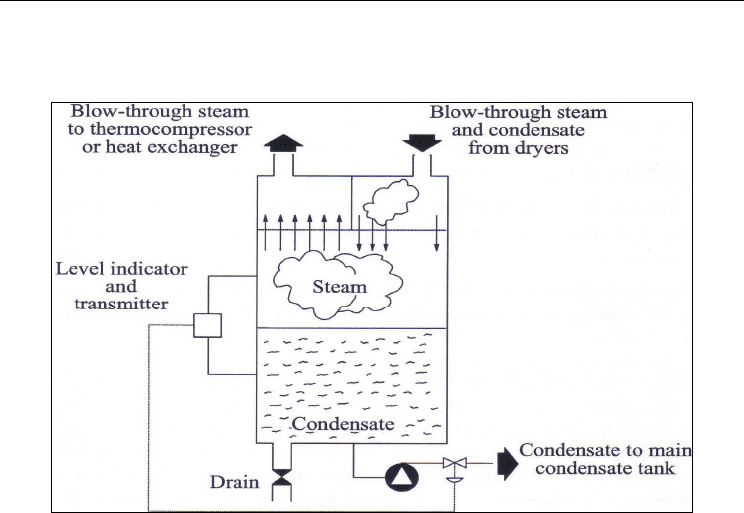
Fundamentals of Paper Drying – Theory and Application from Industrial Perspective
553
requirement of higher differential pressure and higher amount of blow-through steam.
Stationary siphons are more efficient and are not very speed dependent with respect to
differential pressure.
Fig. 5.4 Condensate separator tank
Condensate along with blow-through steam evacuated from the dryer or a dryer group is
collected in tank called ‘separator’. Here the two-phase steam and condensate mix is
‘flashed’ to generate low pressure steam in the upper part of the separator as shown in
Figure 5.4. The condensate is generally returned to the boiler house. The flash steam
contains good valuable heat and should not be wasted by ventilation to the atmosphere. The
heat content in terms of latent heat of flash steam is exactly the same as line steam. The
flashed steam can be piped to the steam supply header of the normally lower steam
pressure preceding group. Quite often a thermo compressor system is used to inject low
pressure steam into dryer by using high pressure motive steam.
In many modern paper machines, a flow control system is used to control the steam and
condensate system using a orifice plate in the blow-through line. This provides a better
control compared to differential pressure control, particularly during web break conditions.
5.3 Troubleshooting of steam and condensate system
Three common problems associated with steam and condensate system are low efficiency;
operating problems and capacity problems. These are discussed below.
5.3.1 Low efficiency problems
The low efficiency could be due to too much blow-through steam and could result in usage of
higher steam per unit mass of water evaporated, siphon failures, steam pressure build-up in
separator and higher differential pressure across the dryers. Reduction in differential
pressure can help but installation of other accessories such as new siphons (if wrong size) or
thermo-compressor is better option in longer term.

Evaporation, Condensation and Heat Transfer
554
5.3.2 Operational problems
Flooded dryer, uneven drying, paper jam and dusting at wet end dryer section are the most
common
operational problems encountered. Symptoms of ‘flooded’ dryer are cold dryer and
oscillating drive motor load. Condensate-filled dryers stay warmer longer even after
shutdown. Use of low differential pressure and likely damage of siphon are possible causes
for ‘flooded’ dryer. Similar to corrective action for low efficiency, increase in differential
pressure and inspection of condensate evacuation system can improve the situation.
Frequent paper jam and excessive dusting in the early dryers could be due to higher surface
temperature and ‘sticking’ of wet web on the dryer surface. This is particularly relevant if
recycled pulp furnish is used. In such situation reduction in steam pressure in earlier
section, shutting down steam supply to selected cylinders could alleviate the problems.
Cylinder surface temperature should be progressively increased to avoid this situation.
5.3.3 Capacity problems
Capacity problems
associated with steam and condensate system are machine speed being
dryer limited and existence of excessive dryer capacity, the later being less common. Dryer
limitation of machine output is reflected at the allowed maximum steam pressure and any
attempt to increase machine speed resulting higher reel moisture. Short term actions such as
increase in press loading, if possible, increase in stock freeness to maximum allowed by
product quality, adjustment of siphon clearance can improve the situation. Redesign of
steam and condensate system is the long term solution. In opposite situation where
excessive drying capacity exists, reel moisture could not be increased without flooding
dryers. Reduced press loading, increase in stock freeness and shutting off selected dryers
could be short term solution.
It is important to note that to carry out evaluation of the steam and condensate system,
necessary information/data must be available. These include machine speed, basis weight,
reel trim, dryer diameter, dryer face width, moisture entering and leaving dryer section,
moisture in and out of size press (if present), available steam pressure, type and size of
steam joint and siphons.
Measuring sheet and dryer surface temperatures is a good and practical method of
evaluating efficiency of heat transfer as well as the performance of the steam and condensate
system in general. Dryer surface temperature can also identify if poor moisture profiles are
caused by non-uniform heat transfer through the dryer condensate layer of by non-uniform
sheet-to-dryer contact. A difference of 10-25
o
C between steam temperature at the operating
pressure and the measured cylinder surface temperature is typical for proper operation. A
difference larger than this usually means condensate build-up in the dryer.
Figure 5.5 shows the comparison of measured cylinder surface temperatures with that of
steam temperatures at the operating steam pressures for two commercial paper machines
producing 80 g/m
2
printing and writing fine paper and heavier linerboard grade packaging
paper. Cylinder surface temperatures of the fine paper machine are within the
recommended range, except for four cylinders that had low surface temperature due to
steam supply to those cylinders being shut off for operational reason. This is an example of
normal operation and good heat transfer. For the linerboard machine, the measured surface
temperatures of all the cylinders are lower than the recommended range. For several
cylinders, the surface temperatures are very low, suggesting inefficient heat transfer and
likely ‘flooding’ of large number of dryer cylinders. Another possibility is inaccurate
readings of pressure gauges/transducers of the data of which is used to calculate steam
temperature.
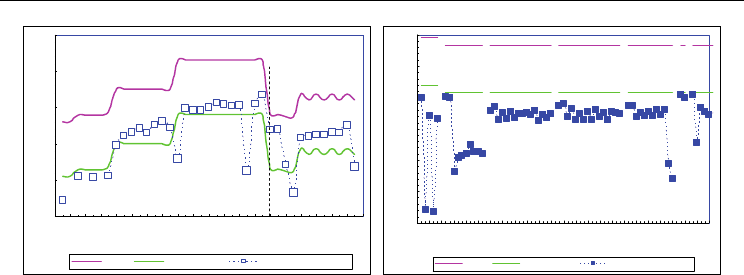
Fundamentals of Paper Drying – Theory and Application from Industrial Perspective
555
50
70
90
110
130
150
0 2 4 6 8 10 12 14 16 18 20 22 24 26 28 30 32 34 36 38 40
DRYER CYLINDERS
TEMPERATURE,
o
C
STEAM RECOM M ENDED CYLINDER (Fine Paper)
Size Press
60
80
100
120
140
160
180
0 3 6 9 12 15 18 21 24 27 30 33 36 39 42 45 48 51 54 57 60 63 66 69 72
DRYER CYLINDERS
TEMPERATURE,
o
C
STEAM RECOM M ENDED C YL INDER ( L in er bo ar d)
Fig. 5.5 Cylinder surface temperatures of a Fine Paper and Linerboard machines
Comparing machine direction sheet temperature development against dryer surface
temperatures can highlight differences within steam groups (for siphon problems).
6. Dryer section ventilation and heat recovery system
As indicated earlier, drying of paper is an interaction between fibres, water and air. In this
respect air handling or dyer section ventilation is one of the most important system
components of water removal from the dryer section of a paper machine (Virtanen, et. al.,
2005). Ever increasing demand for faster paper machine and superior product quality
require more efficient air handling and ventilation system. Dryer section ventilation is often
linked with heat recovery from the dryer pocket exhaust where heat recovered from the
primary stage is used to heat the ventilation air.
6.1 Pocket ventilation
Dryer pocket is defined as the space in the dryer section between two adjacent cylinders, in
case of single-tier system, or between three cylinders, in case of conventional two-tier
system. Individual pocket is separated by dryer fabric and paper web. In this area majority
of evaporation occur from the web. For the efficient drying of paper, it is extremely
important to remove the water vapour from around the web to increase the driving force for
evaporation. Increasing the cylinder surface temperature does not necessarily improve the
water removal rate during paper drying process, as water evaporated from the web must be
removed from the pockets by sufficiently hot and dry air. If the movement of air in the
pockets is too low or close to stagnation, higher temperature in the pockets does not help in
improving drying rate. There should be sufficient airflow in the pockets for efficient drying.
Quite often the importance of dryer pocket ventilation is neglected. This is particularly true
for older machines. Due consideration of pocket ventilation and air handling are not given
by mills when a major upgrade in dryer section is undertaken. In today’s high speed
machine, the ventilation systems should be an integral part of the papermaking process and
not separately designed from the rest of the dryer section. The hood and the dryer section
ventilation system must be able to perform many basic functions (Karlsson, 1995):
-
capture and remove water evaporated in the dryer section
-
create a controlled and favorable environment for the drying process
-
improve energy utilization and energy economy in the drying process
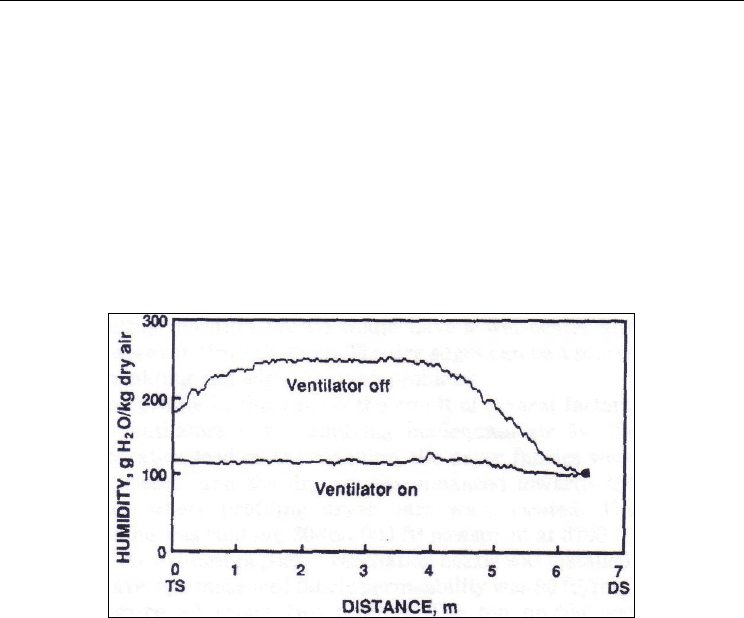
Evaporation, Condensation and Heat Transfer
556
- improve the runnability of the machine not only by means of runnability systems but
also through the proper distribution and control of airflows throughout the entire dryer
section
-
maintain good working conditions in the machine room in terms of heat, humidity and
noise
-
protect the building and machinery from deterioration because of the humidity
-
reduce emissions and mist to the outside of the mill.
The importance of pocket ventilation is illustrated in Figure 6.1. For paper machine
equipped with pocket ventilator, will have lower and uniform absolute humidity profile
across the width of the dryer pocket. However, for paper machines that do not have pockets
ventilator can have very high and non uniform humidity. High pocket humidity can have
negative effect on drying energy consumption and non-uniform humidity will create
problem reel moisture profile.
Fig. 6.1 Effect of Pocket Ventilation
An accurate measurement of relevant data (air temperatures or dry bulb temperatures,
relative humidity or wet bulb temperatures and air movements in each pocket) that quantify
pocket conditions is crucial for performance analysis and subsequent improvement. These
data were measured each time the dryer section of a paper machine was audited as part of a
systematic approach. In several cases, it is necessary to measure pocket conditions across the
full machine width and in such situations, a data logger could be used. A hot-wire
anemometer velocity probe is generally used for measurement of air movement in the
pockets. Either a humidity probe or dry and wet bulb temperature measurement probe can
be used for the measurement of humidity. Depending upon the probe used, thermodynamic
equations can be used to calculate absolute humidity (AH), dew point temperatures or
relative humidity. Once the pocket air condition data are gathered, detailed analysis of
pocket ventilation system can be carried out (Hill, 1993; Afzal, 2000).
Figure 6.2 shows the example of a paper machine producing kraft paper with
poor pocket
conditions. The majority of the pockets in the third or main section and two pockets in the
second or intermediate section had absolute humidity values significantly higher than the
maximum recommended value of 0.2 g water/g dry air. Cross machine profiles of pocket
conditions of this machine was measured. The peak absolute humidity values of each pocket
are also shown in this figure. As expected, peak AH value were significantly higher than the
pocket average values.
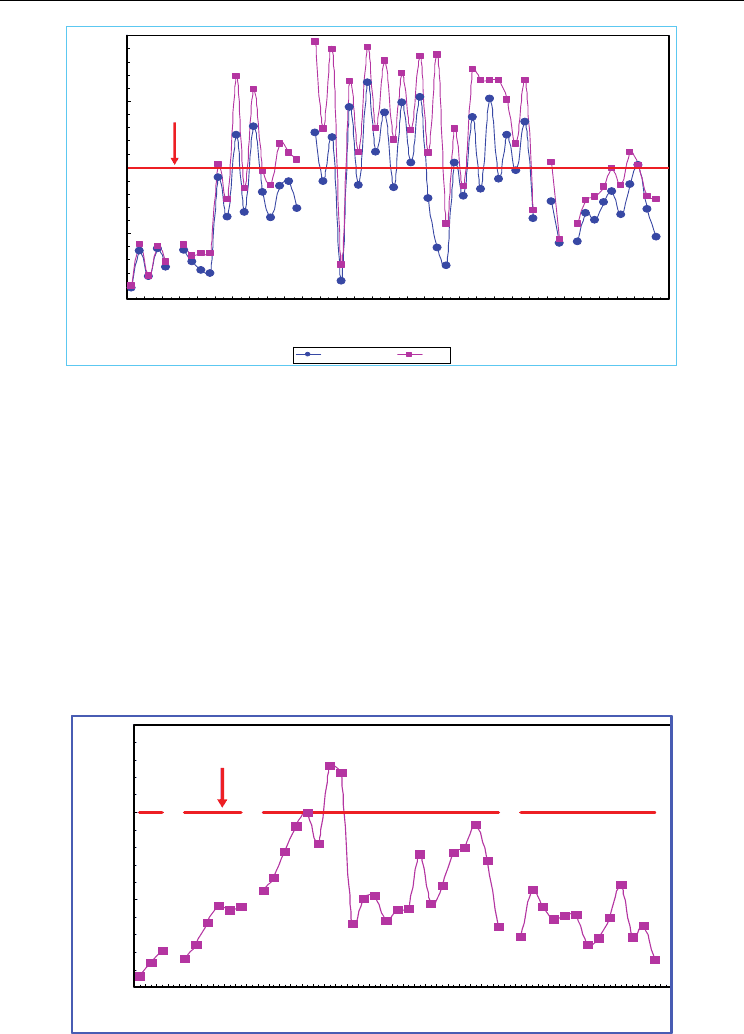
Fundamentals of Paper Drying – Theory and Application from Industrial Perspective
557
0.00
0.10
0.20
0.30
0.40
1
2
3
4
5
Sec 1
6
7
8
9
10
11
12
13
14
15
16
17
18
19
Sec 2
20
21
22
23
24
25
26
27
28
29
30
31
32
33
34
35
36
37
38
39
40
41
42
43
44
45
Sec 3
46
47
Sec 4
48
49
50
51
52
53
54
55
56
57
Sec 5
DRYER POCKET NUM BER
ABS. HUMIDITY, g WATER/ g AI
R
Pocket Average Peak
MAXIMUM
TA R G ET
Fig. 6.2 Example of
Poor pocket conditions (Machine A : Linerboard)
Examples of a paper machine producing newsprint with
good pocket conditions are shown
in
Figure 6.3. Except two pockets (#16 and #17), the AH values of all the other pockets were
less than 0.20 g water/g dry air. For both these machines, cylinder surface temperatures
were within acceptable range at the operating steam pressures. These examples suggest that
the steam/ condensate system and the pocket ventilation of the dryer sections are equally
important in improving dry-end efficiency of a paper machine. In many newer and also
some older machines with upgraded hood and PV system, both ‘supply’ and ‘exhaust’ air
fans are equipped with variable speed drives. This would enable fine tuning of the air
system. Moreover, the supply air is such machines are distributed into individual pockets
through headers and damper arrangements. Systematic and extensive audit of the air
system in the dryer section can establish precise requirement of the amounts of air in each
pocket that could be subsequently adjusted by different damper settings.
0.00
0.10
0.20
0.30
1
2
3
Sec 1
4
5
6
7
8
9
Sec 2
10
11
12
13
14
15
16
17
18
19
20
21
22
23
24
25
26
27
28
29
30
31
Sec 3
32
33
34
35
36
37
38
39
40
41
42
43
44
Sec 4
DRYER POC KET NUM BER
ABS. HUMIDITY, g WATER/ g AI
R
MAXIMUM
RECOM M ENDED
Fig. 6.3 Example of
good pocket conditions (Machine B : Newsprint)
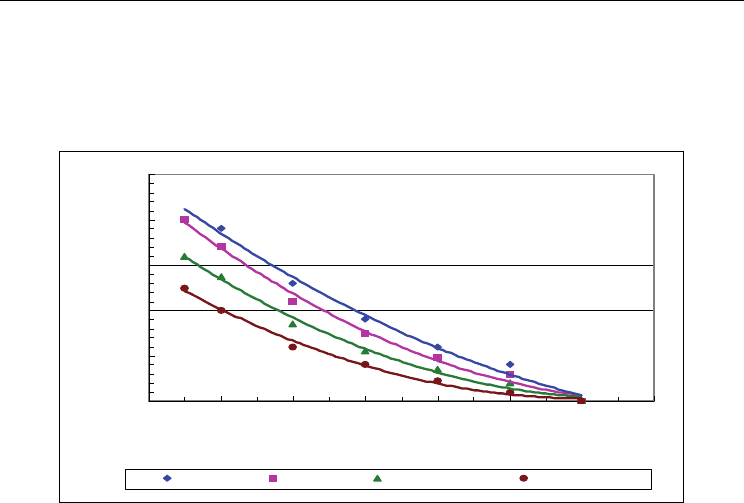
Evaporation, Condensation and Heat Transfer
558
Besides saving in drying energy and improving reel profiles by optimal pocket ventilation,
reducing absolute humidity inside the pockets can lead to increase in drying rate with
consequential increase in machine output. The effect of absolute humidity on drying rate is
shown in Figure 6.4. The highest benefit could be realized for light-weight grade of paper
such as newsprint.
0
10
20
30
40
50
0 0.1 0 .2 0 .3 0 .4 0 .5 0.6 0 .7
Avergae AH (g water/g air) All Pockets
Change in Drying Rat
e
NP FP Medium Linerboard
Fig. 6.4 Effect of pocket absolute humidity of drying rate (Perrault, 1989).
6.2 Dryer hood
Dryer hood is the enclosed space above the dryer section of a paper machine spanning the
length from the last press to the reel. In the early days, paper machine did not have any
hood. This used to cause the working condition unbearable for the machine crew. There was
continuous dripping of condensed water vapour everywhere with the machine building
deteriorating. Later on, dryer sections were covered with open canopy hoods, which made a
significant difference. However, these open hoods were not optimal in terms of energy
efficiency, nor could the airflows and draft around and within the dryer section be
controlled any way. The evolution finally led to closed hoods, with advantages that are well
known. From the outside it may appear that the technology is quite simple and that all
hoods are alike. However, an efficient hood concept requires a profound knowledge of the
paper drying process and the phenomena taking place in the dryer section.
A well designed closed hood is much more than an enclosure over the dryer section.
Together with the process ventilation system, and heat recovery, it provides the papermaker
with all the tools necessary to ensure full control over drying performance and energy
consumption in the dryer section.
6.2.1 Hood balance
The airflows required to ventilate the hood effectively are highly dependent on the
construction of the hood and its operation. Enough air must be introduced to the hood to
prevent condensation and keep pocket humidities low enough to maintain high drying
rates. Exhaust airflows must prevent vapour from spilling into the machine room. It is
necessary to carry out a hood balance in order to identify potentials for improving drying
